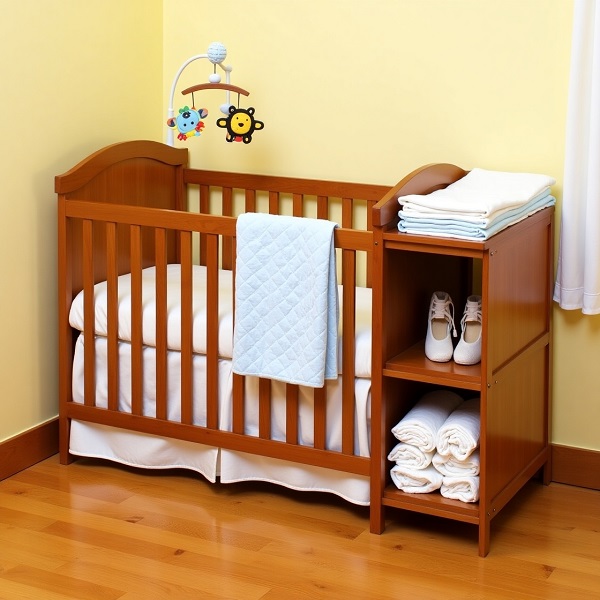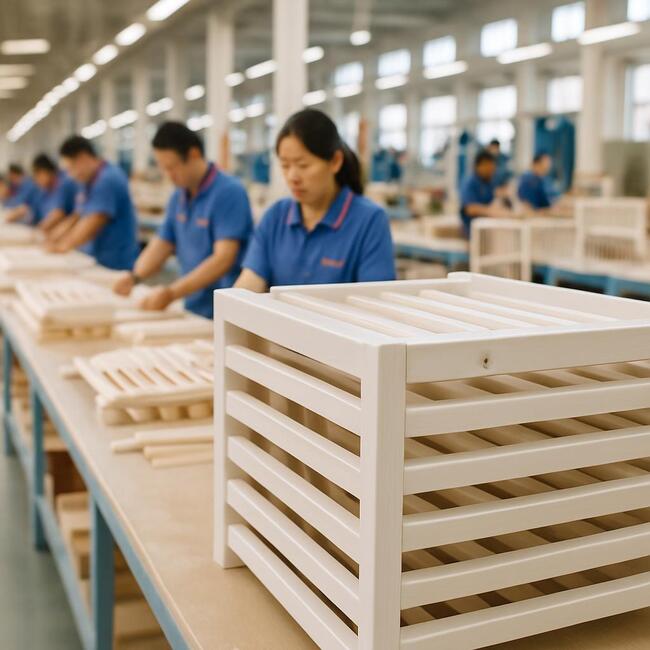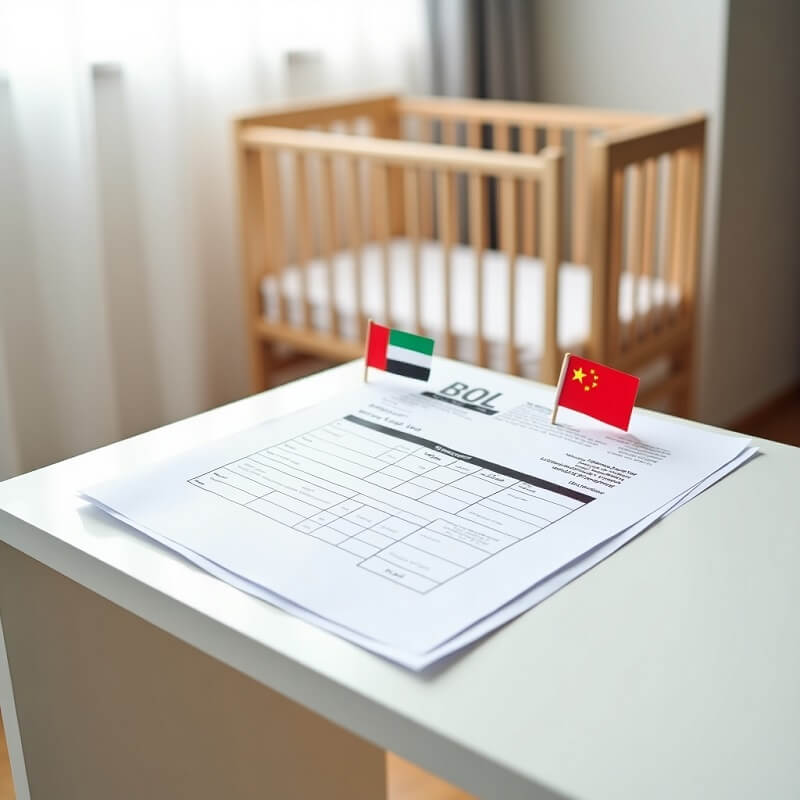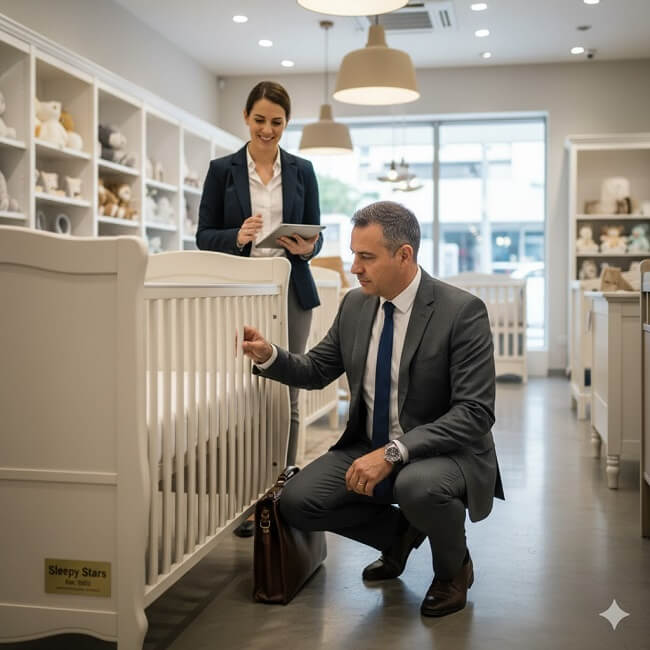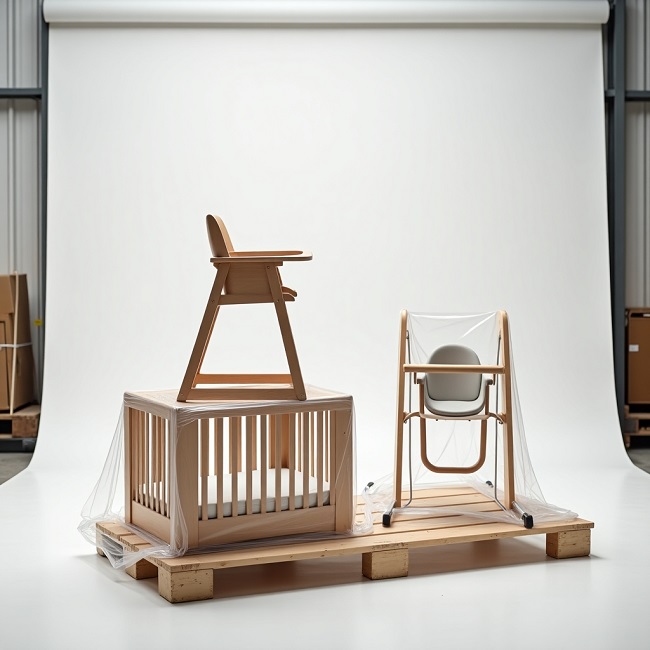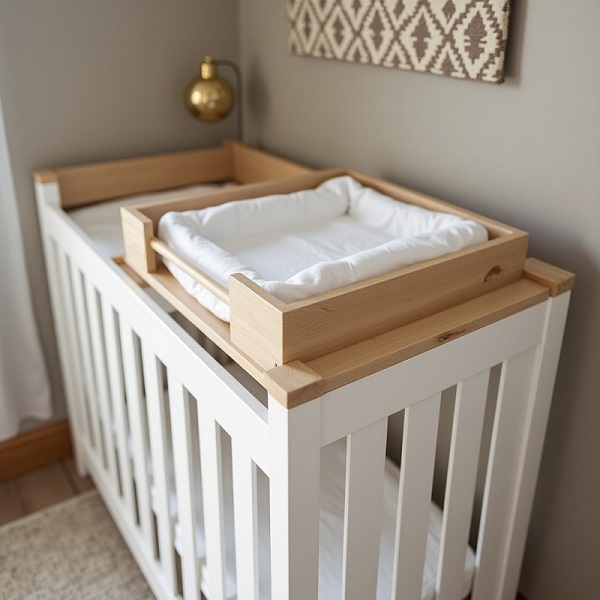Welcome to the “equipment” exploration journey for new parents! Alongside the excitement of welcoming your little one, choosing safe, practical, and satisfactory items for your baby has become a sweet yet slightly “challenging” task.
Today, we focus on a furniture option that seems to “kill two birds with one stone”: a crib with a built-in changing table. It promises to save precious space, keep care essentials within arm’s reach, and even save on budget – an undeniably huge attraction for families with limited living space or those aiming to streamline their baby gear.
In this guide, we’ll set aside the fancy marketing hype and return to real-world experience and safety considerations. Together, we’ll analyze the core value proposition of this crib/changing table combo, the practical convenience it offers, and the potential limitations you might not have fully weighed.
What Is a Crib with a Changing Table Combo?
Imagine your baby’s crib isn’t just a place for sleep but also a “part-time” task station—for diaper changes. That’s the core idea behind a crib with a changing table (often called a crib/changing table two-in-one).
Simply put, it’s a standard crib with a detachable or foldable table cleverly integrated. This table is usually positioned at one end (head or footboard), though some designs place it on the side. Think of it as adding a dedicated “work platform” to the crib—perfect for diaper changes, dressing, and quick baby checks.
Key Features of the Changing Table:
✔ Flat, Stable Surface – Provides a firm, spacious area to keep your baby safe and comfortable during changes. The material typically matches the crib frame or includes an easy-to-clean mat.
✔ Protective Barrier – The table has short guardrails on three (sometimes four) sides, usually a few inches high. This isn’t just for looks—it prevents rolling and adds a critical safety layer.
✔ Removable/Foldable Design – The secret to its “two-in-one” versatility. When needed, simply unfold and lock the table in place. After use, it folds or detaches easily, letting the crib return to pure sleep mode without hogging extra space.
✔ Convenient Storage (Optional) – Some models include small hooks, mesh pockets, or shallow shelves underneath or beside the crib. This keeps diapers, wipes, or cream within arm’s reach, so you’re always prepared.
Key Advantages of Crib/Changing Table Combos

Choosing a crib with a built-in changing table isn’t just about novelty—this two-in-one design solves real pain points for new parents, offering undeniable conveniences:
Space-Saving “Savior”
This is its biggest standout feature. For apartment dwellers or those with compact nurseries, every square foot matters.
A standalone crib + changing table (even in minimalist designs) consumes significant space, making rooms feel cramped. But this combo design stacks two essential functions into the same footprint—like adding a foldable shelf to a desk: more utility, zero extra space.
Efficiency First – Nighttime Diaper Changes Made Easy
Newborn care—especially at 2 AM—is a battle against time and exhaustion. Picture this: Your baby cries, you lift them, stumble across the room to a separate changing table, fumble for lights, then scramble for diapers… Each step drains energy.
The combo cuts the hassle. The ultra-short workflow—”lift baby → unfold table → start changing”—is priceless during midnight fusses or sleep-deprived moments. Less chaos, smoother routines.
Budget-Friendly
Let’s be real: Kids are expensive. Buying a safe, high-quality crib plus a sturdy standalone changing table adds up fast.
While combo units may cost slightly more than a basic crib alone, they’re far cheaper than buying both pieces separately. The savings can go toward other essentials—premium diapers, clothing, or developmental toys.
Visual & Psychological “Tidiness”
Merging two core items into one reduces bulky furniture clutter. This minimalist approach creates a sense of order—critical when baby gear threatens to overrun your space.
One less large item = one less magnet for mess.
Potential Drawbacks to Consider Carefully
Like all products, cribs with changing tables have trade-offs. While their space-saving and budget-friendly features are appealing, it’s important to weigh these inherent limitations before purchasing:
The Awkward Height Dilemma
The most frequent concern mentioned in user reviews relates to safety and accessibility—cribs are generally designed to be 20 to 24 inches high to prevent climbing and allow easy access to the baby.
Including a changing table (typically 2–4 inches thick) elevates the working surface to 22–28 inches or more, often requiring parents to reach up or even stand on tiptoe while using it. This strains shoulders, necks, and backs, especially compared to standalone changing tables designed at the ideal waist height (35-39 inches) for adult comfort.
Stability and Weight Limit Concerns
The changing table is essentially an add-on structure to the crib frame.
While cleverly designed, it lacks the rock-solid stability of a four-legged standalone unit. When babies start rolling, twisting, or kicking (around 3-4 months), the slight wobble can unsettle parents.
Always check the manufacturer’s weight limit—combo tables typically support less weight than their standalone counterparts.
Short Functional Lifespan
Babies grow alarmingly fast!
Once your little one begins rolling, crawling, or attempting to stand (typically 4-8 months), the changing table becomes a safety hazard and must be removed immediately. A fall from this height could be dangerous.
However, a well-designed independent changing table can usually be used safely until the baby is about 2 years old (or the weight/height reaches the upper limit) because it has a more stable structure, the protective fence is usually higher, and the height design is more difficult to climb.
The combo’s changing function may only last a few months, drastically reducing its cost-effectiveness.
Who Should Buy a Crib with a Changing Table?
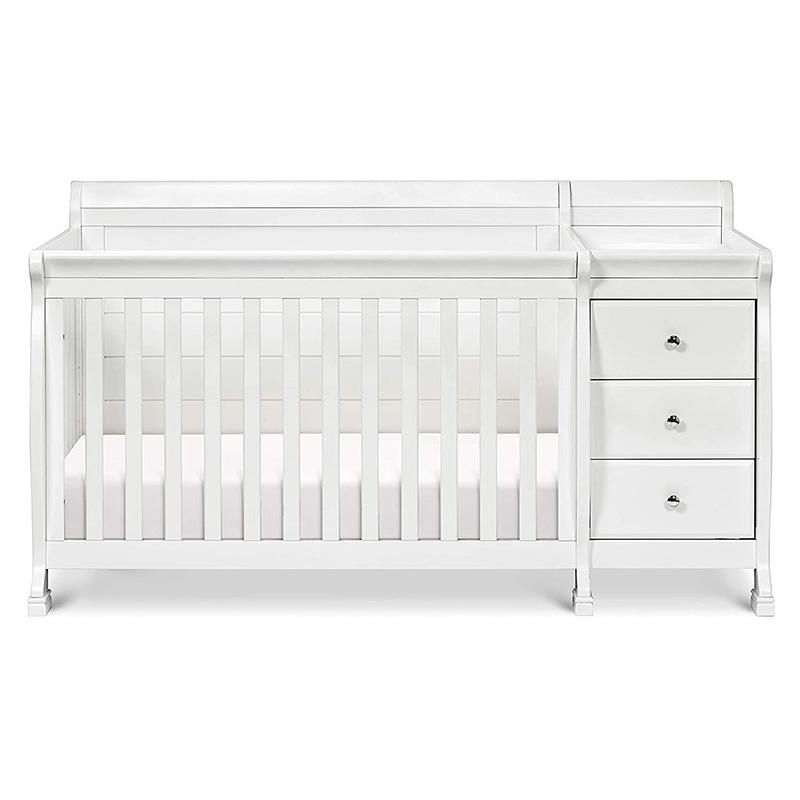
Families where space is a “luxury”
Typical scenario: Living in a compact apartment, small house, or the baby’s bedroom/nursery corner itself is very limited. The baby’s room may also serve as a study, storage room, or even just a small area in the master bedroom.
Why it’s suitable: When every square centimeter has to be carefully calculated, saving space for a separate diaper table is of great significance. Combination design compresses two core functions into a single footprint, which is the most direct solution to the hard constraints of space.
Pragmatic parents who prioritize budget
Typical mentality: Want to spend money on the right things while ensuring basic safety and functionality. Willing to accept certain functional compromises (such as a slightly shorter diaper changing table life, and limited storage) in order to save a considerable amount of money on baby furniture.
Why it’s suitable: The price of the combination product is usually lower than the sum of “high-quality crib + high-quality independent diaper table”. The saved budget can be flexibly used to purchase other necessities (such as safety seats, breast pumps, and more consumables) or as a reserve fund.
Families who need short-term convenience and are aware of the limited “service life”
Typical scenario: Plan to stop using the table function before the baby can roll over/crawl (usually 4-6 months); or although the table is used for a short time, it is valued for the “one-stop” convenience it brings during the newborn period (especially at night), and the convenience value of these months exceeds its cost.
Why it is suitable: This type of family has a clear expectation of the functional life of the product and does not expect it to last for a long time. They value the convenience of “reaching out” during the most hectic first few months and are willing to pay for it.
If You Decide to Buy:
✅ Safety first: Choose products meeting strict standards (e.g., China’s GB 29281-2012 or U.S. ASTM F1169).
✅ Ensure safety straps are fastened during every diaper change, and never leave your baby alone on the changing surface.
✅ Retire the tabletop immediately when the baby shows signs of rolling/crawling/standing (often earlier than anticipated!).
FAQ
1. Is a crib with a changing table safe for newborns?
Yes, cribs with changing tables can be safe for newborns as long as they meet safety certifications like CPSC or JPMA and follow proper crib safety guidelines.
2. Can the changing table be removed later?
It depends on the model. Some combo cribs have detachable changing tables or ones that convert into nightstands or storage units as your child grows. Others are fixed as part of the crib structure, which limits flexibility.
3. Are crib and changing table combos hard to assemble?
Most models come with detailed instructions and are manageable for two adults to assemble within 1–2 hours.
4. How much weight can the changing table hold?
The weight limit for changing tables typically ranges from 15 to 30 pounds (6.8–13.6 kg).
5. Do crib combo units come with a changing pad?
Some models include a thin changing pad, but the quality may vary. For better comfort and safety, you might want to purchase a contoured changing pad with a non-slip base and secure safety straps separately.
Conclusion
After an in-depth analysis of the crib combination with a diaper changing table – from its shining points of saving space and improving efficiency to its practical limitations of being highly awkward and having a short service life – I believe that at this moment, you already have a clearer outline in your mind.
Regarding the core question of “Is it worth buying?”, the answer is not a simple yes or no, but whether it accurately fits your family’s current unique needs, space conditions, and lifestyle.
No matter how much you are attracted by its convenience, be sure to choose a product that meets strict safety standards (such as GB 29281, ASTM F1169) and abide by the iron rule: use safety straps, stay with your baby at all times, and stop using the table function immediately when the baby can turn over and crawl. Safety, no room for compromise.
Recommended Related Articles:
- What Is a Convertible Crib?
- What Is a Mini Crib? A Complete Guide
- When to Lower the Crib Mattress?
- How to Choose a Crib for Your Child?
- Crib Types and Styles: A Complete Guide
- When to Transition Baby to Crib?
- Can Twins Sleep in the Same Crib? A Complete Guide for Parents
- How to Get Your Baby to Sleep in the Crib After Co-Sleeping?

